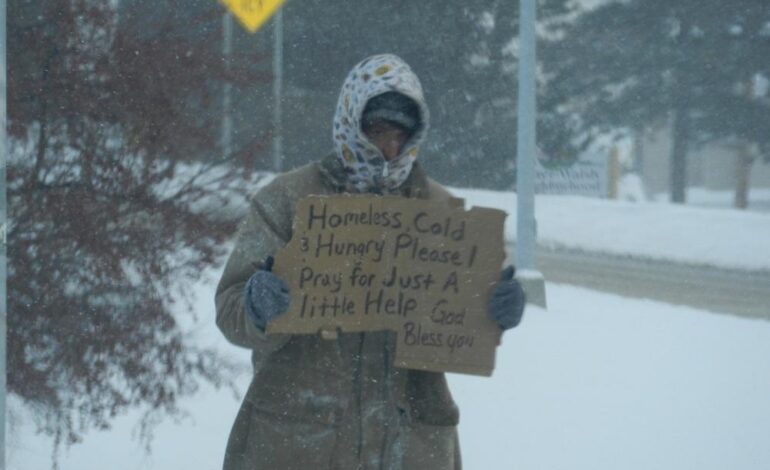DETROIT — The state of Michigan has released its 2020-2022 State Action Plan to end and prevent homelessness.
More than 65,000 people in Michigan experienced homeless in 2018, according to the Michigan State Housing Development Authority annual report. The data reflects the projected number of literally homeless people, including individuals and families residing on the streets, in emergency shelters, in cars or in places like abandoned homes. The report did not count people who live with family members or friends.
The homeless count was divided by subpopulation: Seniors 55 and older (8,367), unaccompanied minors under 18 (711), youth (3,995), veterans (3,605), chronic (6,235), children in families (16,391), adults in families (12,568) and singles 25 and older (27,907).

Michigan’s homeless population projected counts, presented by region— MCTEH 2018 Annual Report
In the Detroit Metro Prosperity Region, region 10, the reported homeless population in 2018 was 16,973. This region accounts for 26 percent of the state’s total homeless population and includes Wayne, Macomb and Oakland counties.
In some communities across the state, communities experienced shortages in affordable housing, wherein in some regions there was a high demand for housing. The National Low Income Housing Coalition identified a substantial need for more affordable housing across Michigan.
Notably, while the youth (18-24) and veterans homeless population continues to decrease, family homelessness is increasing, and the $649 monthly household income is below the amount needed for sustainable housing.
Other challenges recognized in the Michigan state housing report include the barrier for those with past evictions or criminal history to access housing, the lack of behavioral health and supportive services funding that limit supportive permanent housing delivery and the increasing number of seniors experiencing homelessness.
As we work to put Michigan on the road to opportunity, we need to keep implementing innovative approaches to ensure everyone in Michigan has a place to call home — Governor Whitmer
Health and racial disparities
The analysis of statewide aggregate data compared homeless individuals with Michigan’s non-homeless population and identified disparities in the area of health. While 14 percent of the general population live with a disability, 44 percent of homeless people live with a disability.
Individuals with disabilities are overrepresented in persons experiencing homelessness. Living with disabilities includes chronic illness, physical disabilities, learning and developmental disabilities, and mental and substance abuse disorders. This creates challenges for finding employment and stable housing.
Out of the homeless people who reported having a disability, 67 percent live with a mental disability, 43 percent with a physical health disability and 28 percent with a substance use disorder.
Only 13 percent of the general population is African American; however, they constitute more than half of the homeless population in Michigan.
“As we work to put Michigan on the road to opportunity, we need to keep implementing innovative approaches to ensure everyone in Michigan has a place to call home,” Governor Whitmer said.
Addressing, preventing and ending homelessness
The U.S. Department of Housing and Urban Development helps communities progress in preventing and ending homelessness. Michigan has four core measures.
Michigan’s Campaign to End Homeless (MCTEH) 2020 to 2022 State Action Plan included four main strategies and measurable objectives.
The first strategy is to increase access to stable and affordable housing. This includes exploring innovative utilization of state and federal resources to fund housing and services (i.e. Temporary Assistance for Needy Families (TANF) for a limited time). This also addresses how to examine tenant selection policies and work with owners and property management.
The second strategy focuses on ensuring system diversion and homelessness prevention. Shelter diversion is an approach that helps people seeking shelter to identify immediate alternative housing arrangements and to connect them with services and financial assistance to help them return to permanent housing.
The third strategy is to advance cross-sector system alignment and address the various barriers to housing. This strategy engages partners in healthcare and behavioral health. It also encourages and supports the development of local partnerships that result in the outreach and stabilization of people experiencing homelessness.
The fourth strategy is to improve the quality of the statewide delivery system, where the MCTEH is committed to supporting individual, agency and community growth and professional development to contribute to stronger outcomes for those with the highest needs across the state.
To access the full 2018 ending homelessness annual report, visit https://www.michigan.gov/documents/mcteh/2018-CTEH_AR_WEB_667374_7.pdf
To read more about MCTEH’s strategies, visit https://www.michigan.gov/documents/mcteh/MCTEH_Action_Plan_2020-2022_699895_7.pdf






Leave a Reply